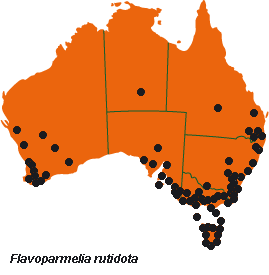



Australian Biological Resources Study
| Checklist of the Lichens of Australia and its Island Territories | ||
| Introduction | A–D | E–O | P–R | S–Z | Oceanic Islands | References | ||
| Flavoparmelia rutidota (Hook.f. & Taylor) Hale | ||
| Mycotaxon 25: 605 (1986); Parmelia rutidota Hook.f. & Taylor, London J. Bot. 3: 645 (1844); Pseudoparmelia rutidota (Hook.f. & Taylor) Hale, Phytologia 29: 191 (1974). T: Van Diemen's Land [Tasmania], J.D.Lawrence; lecto: FH, fide M.E.Hale, Smithsonian Contr. Bot. 31: 44 (1976). ***** Parmelia subconspersa Nyl., Flora 52: 293 (1869); Parmelia conspersa var. subconspersa (Nyl.) Stein in H.H.J.Meyer, Ostafrikanische Gletscherfahrten 316 (1890). T: Sydney, N.S.W., 1862, L.Lindsay s.n.; lecto: H-NYL 34968, fide V.K.Gyelnik, Ann. Hist.-Nat. Mus. Natl Hung. 29: 49 (1935). ***** Parmelia jeleneckii Kremp. in E.Fenzl, Reise Novara: Lichenes 2: 114 (1870); Flavoparmelia jeleneckii (Kremp.) Hale, Mycotaxon 25: 605 (1986). T: New Holland [Australia], 1858, C.Jeleneck; lecto: M; isolecto: W, fide M.E.Hale, Smithsonian Contr. Bot. 31: 45 (1976). ***** Parmelia subcaperatula Nyl. in J.M.M.Crombie, J. Linn. Soc., Bot. 17: 394 (1880). T: Derwent River, Tas., R.Brown s.n.; lecto: H-NYL 35730; isolecto: BM, n.v., fide M.E.Hale, loc. cit. (1976). ***** Parmelia ochroleuca Müll.Arg., Flora 65: 306 (1882), nom. illeg. non Parmelia ochroleuca (Hoffm.) Ach., Methodus 271 (1803). T: Illawarra in Novae Hollandiae regione [Illawarra Region], N.S.W., Australia, 1877–1887, W.Kirton 1; lecto: G; isolecto: MEL, fide R.B.Filson, Austral. J. Bot. 30: 561 (1982). ***** Parmelia confertula Stirt., Trans. & Proc. New Zealand Inst. 32: 77 (1899). T: Darling Downs, Qld, F.M.Bailey; lecto: BM, fide M.E.Hale, loc. cit. (1976). | ||
| Thallus adnate, to 5–20 cm wide. Lobes imbricate, 2–8 mm wide; margins crenulate; lobulate or not; apices subrotund. Upper surface yellow-green to pale green, ±rugulose at margins becoming more densely rugose towards centre, dull, sometimes slightly shiny, lacking soredia, dactyls and isidia. Medulla mostly white, often with scattered cream to yellow patches, especially in lower medulla. Lower surface rugulose; rhizines sparse, simple. Apothecia sessile, 2–7 mm wide; disc concave, cinnamon-brown to dark brown; thalline exciple strongly involute, becoming rugulose. Ascospores 12–16 × 8–11 µm. Pycnidia common. Conidia bacilliform, 7–8 × 1 µm. CHEMISTRY: cortex K-, UV-; medulla K-, C-, KC-, P+ deep orange; yellow pigment (when present) in lower medulla K-; containing usnic acid, protocetraric acid (major), caperatic acid, ±atranorin, ±secalonic acid A (in pigmented medulla) and with or without unidentified compounds (trace). |  |
|
| Very common throughout temperate and subtropical Australia (all States and Territories); also occurs in southern U.S.A. Grows on bark of trees and dead wood, rarely on rock. | ||
| Elix (1994g) | ||
| Checklist Index |
| Introduction | A–D | E–O | P–R | S–Z | Oceanic Islands | References |
This work is copyright. Apart from any use as permitted under the Copyright Act 1968, no part may be reproduced by any process without prior written permission from Australian Biological Resources Study. Requests and inquiries concerning reproduction and rights should be addressed in the first instance to Dr P. McCarthy. These pages may not be displayed on, or downloaded to, any other server without the express permission of ABRS.